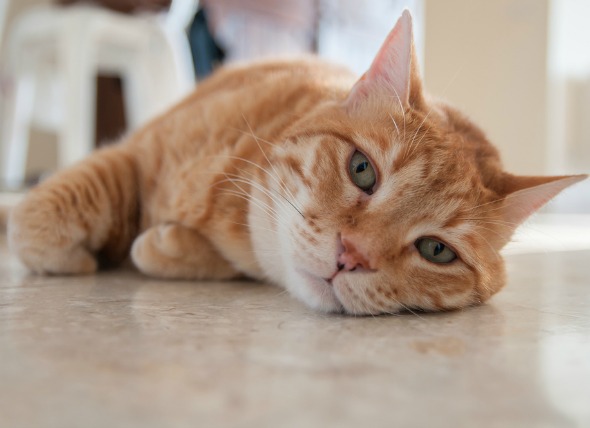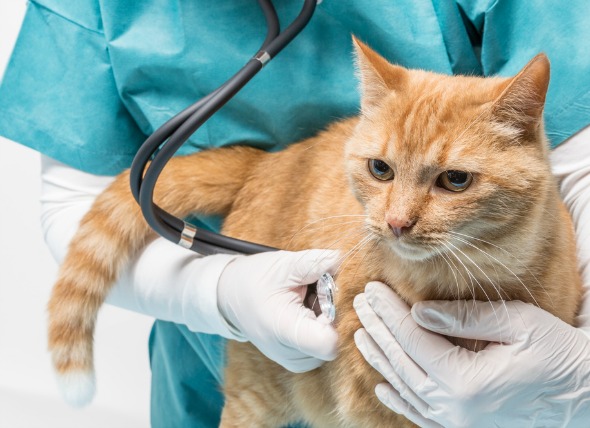

Bromethalin rodenticide toxicity, more commonly referred to as rat poisoning, occurs when an animal is exposed to the chemical bromethalin, a toxic substance that is found in a variety of rat and mice poisons. Ingestion of bromethalin can lead to cerebral edema (the accumulation of excess water in the brain), and an increase in pressure of cerebrospinal fluid - the liquid within the membrane of the skull that the brain essentially floats in. A variety of neurological-based symptoms can result from this, including muscle tremors, seizures, and impaired movement.
While other species may be affected by the accidental ingestion of rat poison, cats are most frequently prone to this condition.
Common symptoms of toxicosis in cats include anorexia (loss of appetite), impaired movement, paralysis of the animal’s hind limbs, slight muscle tremors, generalized seizures, and a depression of the central nervous system. Ingestion of extremely high doses may cause a sudden onset of muscle tremors, and even seizures.
Clinical signs usually develop within two to seven days of bromethalin ingestion, however it is possible that signs will not develop for up to two weeks following ingestion. If poisoning is mild, with minimal bromethalin ingestion, symptoms may resolve within one to two weeks of onset, although some animals may continue to show signs for four to six weeks.
Bromethalin rodenticide toxicity occurs with the ingestion of rodenticides containing the chemical bromethalin. Cats may also be targets of secondary poisoning if they eat rats or mice that have ingested the poison themselves. Toxic doses of bromethalin are estimated to be 0.3 milligrams per kilogram of body weight for cats.
If bromethalin toxicosis is suspected, testing will include a urine analysis, and brain imaging with magnetic resonance imaging (MRI), or a computed tomography (CT) scan, which may reveal excess fluid in the brain.
Other possible diagnoses that may cause symptoms similar to those of bromethalin toxicosis include neurological syndromes produced by traumatic events (such as a car accident), exposure to other infectious and toxic agents, or a tumor growth.
If bromethalin toxicosis occurs, your cat's digestive tract will need to be decontaminated as soon as possible. This may initially be done by induced vomiting, followed by administering activated charcoal to neutralize any remaining poison, and an osmotic cathartic to induce your cat's bowels to empty. This should be done every four to eight hours for at least two days following the poisoning, or as prescribed by your veterinarian. Some medications that can be used to control symptoms such as muscle tremors and seizures are also available.
Bromethalin toxicosis can cause prolonged appetite loss (anorexia). If your cat is experiencing this symptom you will need to administer feeding supplements for a time after initial treatment. It may take several weeks to recover from mild poisoning, and symptoms should be monitored accordingly to avoid further complications.
To prevent bromethalin toxicosis, ensure that your cat does not have access to rodent poisons. If you are using rat poison in a home with cats, you will want to avoid secondary poisoning resulting from your cat ingesting a rat that has been poisoned. You will also need to be watchful for dead rodents so that you can properly dispose of them before your cat can get to them. Also important is to be attentive over your cat. If your cat does catch a rat, and you have been putting poison out, you will need to get the rodent away from your cat before it has ingested a damaging amount of the poison.
 Lung Cancer (Adenocarcinoma) in Cats
Lung Adenocarcinoma in Cats
Adenocarcinoma is a m
Lung Cancer (Adenocarcinoma) in Cats
Lung Adenocarcinoma in Cats
Adenocarcinoma is a m
 Noisy Breathing in Cats
Stertor and Stridor in Cats
Stertor is noisy brea
Noisy Breathing in Cats
Stertor and Stridor in Cats
Stertor is noisy brea
 Pancreatic Cancer in Cats
Insulinoma in Cats
Insulinomas are malignant neop
Pancreatic Cancer in Cats
Insulinoma in Cats
Insulinomas are malignant neop
 Paralysis in Cats
Loss of Body Movement in Cats
A cat’s abili
Paralysis in Cats
Loss of Body Movement in Cats
A cat’s abili
 How Chronic Stress Can Affect Both Your Life And Your Cats
Looking at the modern cat&rs
How Chronic Stress Can Affect Both Your Life And Your Cats
Looking at the modern cat&rs
Copyright © 2005-2016 Pet Information All Rights Reserved
Contact us: www162date@outlook.com